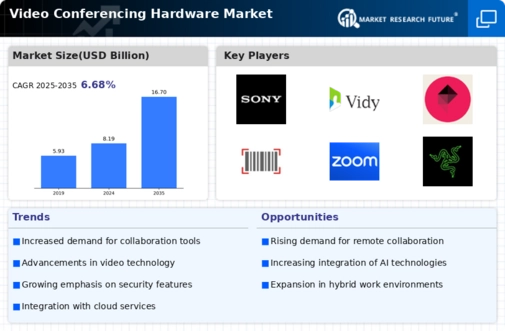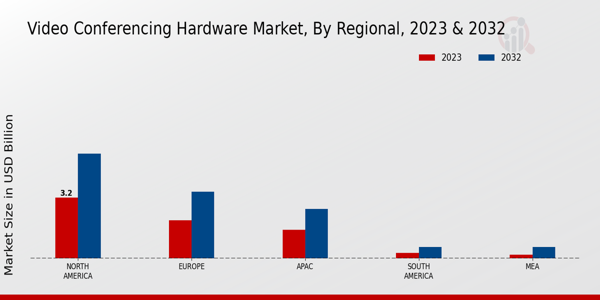Market Growth Projections
Globalization and Cross-Border Communication
Globalization significantly impacts the Global Video Conferencing Hardware Market Industry, as businesses expand their operations across borders. The need for effective communication tools that facilitate cross-border collaboration is becoming increasingly vital. Companies are investing in video conferencing hardware that allows for seamless interactions with international teams and clients. This trend is particularly pronounced in industries such as technology, finance, and consulting, where timely communication is essential. As organizations navigate the complexities of global operations, the demand for reliable video conferencing solutions is expected to rise, further propelling market growth in the coming years.
Increasing Adoption of Remote Work Solutions
The Global Video Conferencing Hardware Market Industry experiences a notable surge in demand due to the increasing adoption of remote work solutions. Organizations are investing in high-quality video conferencing systems to facilitate seamless communication among dispersed teams. In 2024, the market is projected to reach 8.19 USD Billion, reflecting a growing recognition of the importance of effective virtual collaboration. Companies are prioritizing hardware that enhances user experience, such as high-definition cameras and advanced audio systems. This trend is likely to continue, as businesses recognize that efficient communication tools are essential for maintaining productivity and engagement in a remote work environment.
Rising Demand for Enhanced Collaboration Tools
The Global Video Conferencing Hardware Market Industry is witnessing a rising demand for enhanced collaboration tools. As organizations increasingly prioritize teamwork and collaboration, the need for effective video conferencing solutions becomes paramount. Businesses are investing in hardware that supports features like screen sharing, real-time collaboration, and interactive whiteboarding. This trend is further fueled by the growing emphasis on hybrid work environments, where employees split their time between remote and in-office settings. The market's compound annual growth rate (CAGR) is projected at 6.68% from 2025 to 2035, indicating a robust growth trajectory driven by the need for effective collaboration tools.
Technological Advancements in Video Conferencing
Technological advancements play a pivotal role in shaping the Global Video Conferencing Hardware Market Industry. Innovations such as artificial intelligence, machine learning, and enhanced video resolution are driving the development of sophisticated hardware solutions. These advancements enable features like automatic framing, noise cancellation, and improved connectivity, which enhance the overall user experience. As organizations seek to leverage these technologies, the market is expected to grow significantly, with projections indicating a market value of 16.7 USD Billion by 2035. The integration of cutting-edge technology into video conferencing hardware is likely to attract businesses aiming to improve their communication capabilities.
Growing Focus on Cost-Effective Communication Solutions
The Global Video Conferencing Hardware Market Industry is experiencing a growing focus on cost-effective communication solutions. Organizations are increasingly recognizing the financial benefits of investing in video conferencing hardware, which can reduce travel expenses and enhance productivity. By enabling virtual meetings, companies can save on travel costs while maintaining effective communication with clients and partners. This trend is particularly relevant for small and medium-sized enterprises (SMEs) that seek to optimize their operational costs. As businesses continue to prioritize cost efficiency, the demand for affordable yet high-quality video conferencing solutions is likely to drive market growth.























